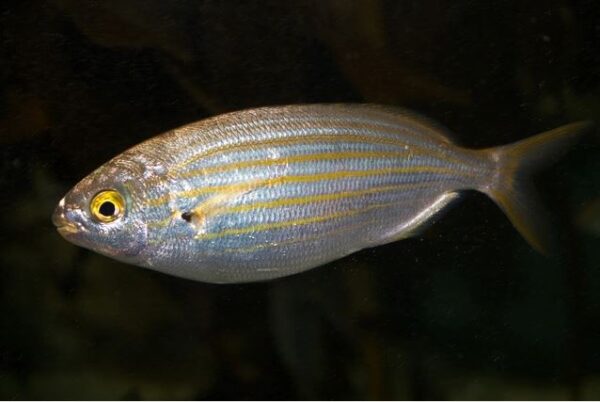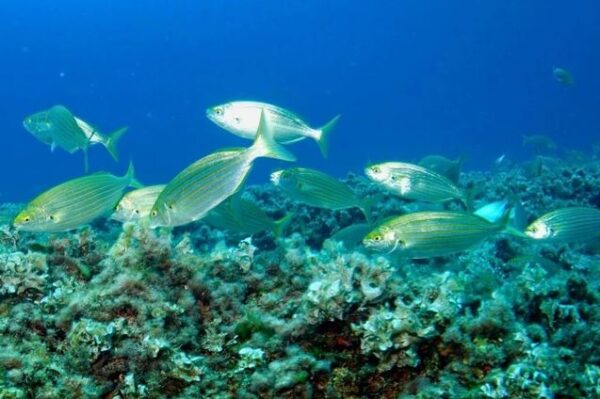Deep in the Mediterranean Sea there is a species of fish unlike any other. This tiny fish hides a secret that normal people do not know: its head is filled with hallucinogens.
Salema porgy is a species of sea bream, commonly known as dream fish, that lives throughout the Mediterranean and the East coast of Africa. Also known as the dreamfish or salema porgy, its most visible features are several conspicuous yellow stripes on the sides of its body.
The appearance of a 2006 article titled, “Ichthyoallyeinotoxism: Two Case Reports from the Western Mediterranean” made this small fish widely known.
The article describes two men who accidentally ate sea bream at a Western Mediterranean restaurant and experienced a series of auditory and visual hallucinations. And this is definitely not a pleasant experience.
The Salema porgy (Sarpa salpa), also known as apricot fish, salema seabream, karanteen, salpa, saupe, strepie or goldline, is a ray-finned marine fish of the family Sparidae, which also includes seabream and porgy. This is the only species in the monotypic genus Sarpa.
First case, April 1994
This case is a healthy 40-year-old man who began to feel unwell and tired after enjoying a dinner of freshly grilled sea bream (Sarpa salpa) while on holiday on the Riviera. belongs to France.
With side effects such as blurred vision, muscle weakness and vomiting that persisted and worsened throughout the next day, the man decided to cut his vacation short and drive home. At that moment, his eyes began to blur and hallucinations gradually appeared around him, he saw many screaming creatures turning and running towards him.
Stunned by the hallucination, he immediately got out of the car and sought medical help. After arriving at the emergency hospital, doctors at the hospital’s emergency department did not know what to do with this man’s case because he had no obvious symptoms other than hallucinations: no fever, no signs of attention or sensory-motor deficits.
When admitted to the hospital, he recovered quickly within 36 hours after eating, with symptoms completely reduced. What was even more strange was that he couldn’t remember a single thing from this experience.
Case 2, March 2, 2002
The other equally strange case is that of a 90-year-old man who began hearing hallucinations two hours after eating sea bream (Sarpa salpa) that he bought from a fisherman. At first, this man continuously heard the cries of people and birds, and had many nightmares over the next two nights.
Unlike the previous case, this man did not tell anyone or go to the hospital for fear that these symptoms were signs of severe mental illness, but instead stayed at home and suffered. Thankfully, the hallucinations disappeared “only” after the next two days.
Salema porgy is not only known for its hallucinogenic properties but also for its fascinating life cycle. These fish are herbivores and feed mainly on algae and seagrass. They are also known for their unique mating behavior. During the breeding season, male salema porgies will gather in large flocks and build nests from seagrass. They will then perform elaborate courtship displays to attract females. Once the female has chosen a mate, she will lay her eggs in the male’s nest. The male will then guard the eggs until they hatch.
These “terrifying” experiences are called ichthyoallyeinotoxism, a rare form of poisoning in which the effects of the poison can cause disruption of the nervous system and are in some respects similar to LSD. Additionally, there is no specific treatment for this form of poisoning. Most people will recover completely within a few days.
In fact, the toxicity of this fish can change with the seasons. This shows that the “hallucinogen” does not come from the fish itself but from its food source – a toxic algae that grows on the seagrass Posidonia Oceanica. Because this algae grows seasonally, the toxicity of the fish also will change seasonally, but this is yet to be confirmed.
According to historians, the ancient Romans considered the heads of sea breams loaded with hallucinogenic toxins a form of entertainment, and the act of eating sea breams was even more common among Polynesians. In Arabic, the name seabream means “fish that makes dreams”, so the Arabs may have also known about its hallucinogenic properties.
Aside from its hallucinogenic head, the fish’s body contains no toxins or other dangers – in fact, the fish is served as a traditional Mediterranean dish, prepared with rosemary and pepper.












